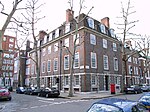Barton Street and Cowley Street, Westminster

Barton Street and Cowley Street are two short streets in Westminster, London. They were developed in the 18th century by the actor Barton Booth, the former taking his first name, and the latter the name of an estate he owned at Cowley, then in Middlesex to the west of London. The streets' proximity to the Palace of Westminster has made them a popular choice for politicians looking for homes within Parliament's Division bell area; the Liberal politician Walter Runciman lived at No.8, Barton Street in the 20th century, and Jacob Rees-Mogg lives at No.7, Cowley Street in the 21st. They have also attracted other notables including; T. E. Lawrence, who wrote much of his Seven Pillars of Wisdom at No. 14, Barton Street; the actor, John Gielgud, who lived at No. 16, Cowley Street and the composer Ralph Vaughan Williams, who had a six-year tenure at No.10, Barton Street. Many of the buildings are listed, most at the second highest grade, II*. Simon Bradley and Nikolaus Pevsner, in the sixth London volume in the Buildings of England series, describe Barton Street and Cowley Street as, "among the most perfect Early Georgian streets in Westminster".
Excerpt from the Wikipedia article Barton Street and Cowley Street, Westminster (License: CC BY-SA 3.0, Authors, Images).Barton Street and Cowley Street, Westminster
Cowley Street, London Millbank
Geographical coordinates (GPS) Address Nearby Places Show on map
Geographical coordinates (GPS)
| Latitude | Longitude |
|---|---|
| N 51.4971 ° | E -0.1279 ° |
Address
Cowley Street 19
SW1P 3NB London, Millbank
England, United Kingdom
Open on Google Maps







